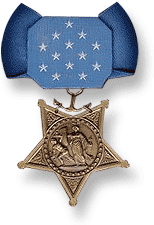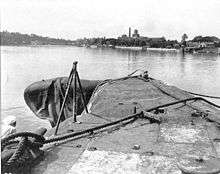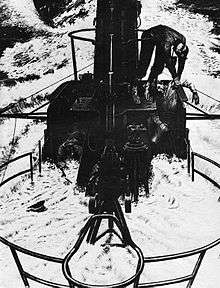Howard W. Gilmore
| Howard Walter Gilmore | |
|---|---|
  Gilmore with first Navy Cross | |
| Born |
September 29, 1902 Selma, Alabama |
| Died |
February 7, 1943 (aged 40) off the Solomons |
| Place of burial | lost at sea |
| Allegiance |
|
| Service/branch |
|
| Years of service | 1920–1943 |
| Rank | Commander |
| Commands held |
USS Shark (SS-174) USS Growler (SS-215) |
| Battles/wars |
U.S. submarine campaign against the Japanese Empire Action of 5 July 1942 Action of 7 February 1943 |
| Awards |
Medal of Honor Navy Cross (2) Purple Heart |
Howard Walter Gilmore (September 29, 1902 – February 7, 1943) was a submarine commander in the United States Navy who received the Medal of Honor posthumously for his heroic self-sacrifice during World War II.
Early life and career
Howard Gilmore was born in Selma, Alabama, September 29, 1902 and enlisted in the Navy November 15, 1920. In 1922 he was appointed to the United States Naval Academy by competitive examination.[1] Standing 34 in a class of 436, Gilmore was commissioned in 1926[1] and reported to the battleship USS Mississippi (BB-41). Gilmore underwent submarine training in 1930 and in the years that followed served in various submarines and at stations ashore.[2]
Gilmore served as the executive officer of USS Shark (SS-174), and in a near-fatal incident during Shark's shakedown cruise, narrowly survived an assault by a group of thugs in Panama, who cut his throat during an excursion ashore. He had to deal with several other instances of tragedy in his life, including the death of his first wife from disease, and at the time of his Medal of Honor action his second wife was still in a coma from a fall she had taken down a flight of stairs.[1] In 1941, he assumed his first command, USS Shark SS-174, only to be transferred the day following the attack on Pearl Harbor to take command of the still-unfinished USS Growler (SS-215).[2]
World War II
Gilmore commanded his submarine skillfully during four Pacific war patrols. During his first, on 5 July 1942 Growler attacked three enemy destroyers off Kiska, sinking one and severely damaging the other two, while narrowly avoiding two torpedoes fired in return, for which Gilmore received the Navy Cross.
On his second patrol, Growler sank four merchant ships totaling 15,000 tons in the East China Sea near Taiwan. Gilmore received a gold star in lieu of a second Navy Cross.
In October 1942, Growler patrolled off of Truk in the Caroline Islands in a repositioning of submarine assets on the way to Brisbane, Australia. No significant action occurred.[3]

4th patrol and Medal of Honor action
The submarine continued to take a heavy toll on shipping on her fourth war patrol, and on the night of 6–7 February 1943, she approached a convoy stealthily for a surface attack. Suddenly a convoy escort, Hayasaki, closed and prepared to ram. As the small ship charged out of the darkness, Gilmore sounded the collision alarm and shouted, “Left full rudder!” — to no avail. Perhaps inadvertently, Growler hit the Japanese adversary amidships at 17 knots (31 km/h), heeling the submarine 50 degrees, bending 18 feet of her bow sideways to port, and disabling the forward torpedo tubes.
Simultaneously, the Japanese crew unleashed a burst of machine gun fire at Growler’s bridge, killing the junior officer of the deck and a lookout,[4] while wounding Gilmore himself and two other men. “Clear the bridge!” Gilmore ordered as he struggled to hang on to a frame. As the rest of the bridge party dropped down the hatch into the conning tower, the executive officer, Lieutenant Commander Arnold Schade — shaken by the impact and dazed by his own fall into the control room — waited expectantly for his captain to appear. Instead from above came the shouted command, "Take her down!" Realizing that he could not get below in time if the ship were to escape, Gilmore chose to make the supreme sacrifice for his shipmates. Schade hesitated briefly — then followed his captain’s last order and submerged the crippled ship.
Surfacing some time later in hope of reattacking the Hayasaki, Schade found the seas empty. The Japanese ship had, in fact, survived the encounter, but there was no sign of Gilmore, who apparently had drifted away in the night. Schade and Growler’s crew managed to control the ship’s flooding and limped back to Brisbane on February 17.
For sacrificing himself to save his ship, Commander Howard Gilmore was posthumously awarded the Medal of Honor, "the second man of the submarine force to be so decorated."[5]
World War II summary
| Departing From | Date | Days | Wartime Credit Ships/Tonnage |
JANAC[6] Credit Ships/Tonnage |
Patrol Area | |
|---|---|---|---|---|---|---|
| Growler-[7] | Pearl Harbor, TH | May 1942 | 15 | zero / zero[8] | zero / zero[9] | Midway Estimated |
| Growler-1 | Pearl Harbor, TH | June 1942 | 27 | 2 / 3,400[10] | 1 / 1,850[9] | Alaska |
| Growler-2 | Pearl Harbor, TH | August 1942 | 49 | 4 / 26,000[11] | 4 / 14,974[9] | East China Sea |
| Growler-3 | Pearl Harbor, TH | October 1942 | 49 | zero / zero[12] | zero / zero[9] | -->Brisbane Via Truk |
| Growler-4 | Brisbane, Australia | January 1943 | 48 | 2 / 7,900[13] | 1 / 5,857[9] | Solomons |
| Ranking | Number of Patrols | Ships/Tons Credited |
Ships/Tons JANAC |
|---|---|---|---|
| 74 | 5 | 8 / 37,300[14] | 6 / 22,681[9] |
Medal of Honor citation

For distinguished gallantry and valor above and beyond the call of duty as commanding officer of the U.S.S. Growler during her Fourth War Patrol in the Southwest Pacific from 10 January to 7 February 1943. Boldly striking at the enemy in spite of continuous hostile air and antisubmarine patrols, Comdr. Gilmore sank one Japanese freighter and damaged another by torpedo fire, successfully evading severe depth charges following each attack. In the darkness of night on 7 February, an enemy gunboat closed range and prepared to ram the Growler. Comdr. Gilmore daringly maneuvered to avoid the crash and rammed the attacker instead, ripping into her port side at 11 knots and bursting wide her plates. In the terrific fire of the sinking gunboat's heavy machineguns, Comdr. Gilmore calmly gave the order to clear the bridge, and refusing safety for himself, remained on deck while his men preceded him below. Struck down by the fusillade of bullets and having done his utmost against the enemy, in his final living moments, Comdr. Gilmore gave his last order to the officer of the deck, "Take her down". The Growler dived; seriously damaged but under control, she was brought safely to port by her well-trained crew inspired by the courageous fighting spirit of their dead captain.[3]
Even today “Take her down!” remains one of the legendary phrases of the U.S. Submarine Force.[5]
Popular culture
Howard Gilmore's sacrifice inspired five different authors and screen writers.
- In the historical notes section epilogue of War and Remembrance (copyright 1978 by Herman Wouk, Library of Congress catalog Card Number 78-17746) Howard Gilmore is recognized by "The death of Carter Aster is based on the famous self-sacrifice of Commander Howard W. Gilmore of the U.S.S. Growler for which he was posthumously awarded the Congressional Medal of Honor"
- In the movie Operation Pacific, John Wayne's character as Executive Officer of USS Thunderfish orders Thunderfish submerged, leaving his wounded Commanding Officer (played by Ward Bond) on the bridge.
- In the movie Submarine Command, on the last day of World War 2 William Holden's character as Executive Officer of USS Tiger Shark orders Tiger Shark submerged while under attack from a Japanese destroyer, leaving his wounded Commanding Officer (played by Jack Gregson) on the bridge.
- In the movie U-571, Bill Paxton's character Lt. Cmdr. Mike Dahlgren (Captain of the S-33) orders Lt. Andrew Tyler (Played by Matthew McConaughey) to take down the captured German U-boat. Tyler complies, leaving his wounded Commanding Officer in the waters.
- In Robb White's novel Up Periscope, Phil Carney as Executive Officer of USS Shark reluctantly submerges the submarine while under attack from a Japanese airplane, leaving his wounded Commanding Officer Paul Stevenson on the bridge after being ordered to "Take her down".
Other posthumous honors
- In September 1943, the submarine tender USS Howard W. Gilmore (AS-16) was named for him and sponsored by his widow.[3]
- A cenotaph (photo of stone can be found[15] in Commander Gilmore's memory and honor was placed by Ed Shields, Ward Calhoun, and the Lauderdale County Department of Archives and History, Inc. at Magnolia Cemetery, Meridian, Mississippi in the Howard Family Plot. His mother's maiden name was Howard.
See also
Notes
- 1 2 3 Blair (1975) pp. 269-270
- 1 2 DANFS
- 1 2 3 Submarine Hero-Howard Walter Gilmore
- ↑ Ensign William Wadsworth Williams and Fireman W. F. Kelly (Blair 1975, p. 374)
- 1 2 Blair (1975) p. 374
- ↑ Joint Army-Navy Assessment Committee. Blair rounded entries in his tables (see Blair p. 900, bottom) while Roscoe's tables are an accurate transcription of the JANAC report.
- ↑ Unnumbered patrol supporting Battle of Midway
- ↑ Blair (1975) p. 909
- 1 2 3 4 5 6 Roscoe (1949) p. 537
- ↑ Blair (1975) p. 914
- ↑ Blair (1975) p. 917
- ↑ Blair (1975) p. 918
- ↑ Blair (1975) p. 923
- ↑ Blair (1975) pp. 984-987
- ↑ "gilmore stone". Lauderdale County Department of Archives & History, Inc.
References
 This article incorporates text from the public domain Dictionary of American Naval Fighting Ships.
This article incorporates text from the public domain Dictionary of American Naval Fighting Ships.
 This article incorporates public domain material from the United States Navy website http://www.navy.mil/swf/index.asp.
This article incorporates public domain material from the United States Navy website http://www.navy.mil/swf/index.asp.
- Whitman, Edward. "Submarine Hero-Howard Walter Gilmore". Undersea Warfare Summer 1999 Vol. 1, No. 4. Chief of Naval Operations Submarine Warfare Division. Retrieved 26 July 2011.
- The Joint Army Navy Assessment Committee (3 February 1947). "Appendix: Japanese Shipping Lost by United States Submarines". Japanese Naval and Merchant Shipping Losses During World War II by All Causes. HyperWar Foundation. Retrieved 23 November 2011.
- Blair Jr., Clay (1975). Silent Victory: The U.S. Submarine War Against Japan. Philadelphia and New York: J. B. Lippincott Company. ISBN 0-397-00753-1.
- Roscoe, Theodore (1949). United States Submarine Operations in World War II. Annapolis, Maryland: United States Naval Institute.
External links
- The short film The Growler Story (1958) is available for free download at the Internet Archive